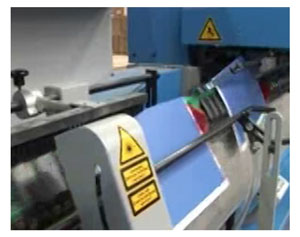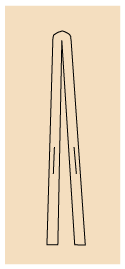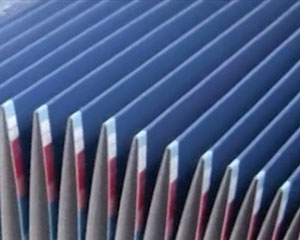 It may sound like a crazy idea, but to veteran saddle stitcher operators it’s nothing new. They already know their saddle stitcher cover feeder is a good alternative to the folding machine for certain types of jobs. Here are three ways you might not have thought about, especially if you’re still learning your way around saddle stitching equipment.
It may sound like a crazy idea, but to veteran saddle stitcher operators it’s nothing new. They already know their saddle stitcher cover feeder is a good alternative to the folding machine for certain types of jobs. Here are three ways you might not have thought about, especially if you’re still learning your way around saddle stitching equipment.
1) Use it to soft fold saddle stitched books. Also called “re-folding,” this is the process in which you take a trimmed, saddle-stitched book and fold it in half again, (see diagram below) usually for mailing purposes.
Newcomers to saddle stitching operations are often surprised that this can be done using their cover feeder. Usually this revelation comes after struggling to re-fold books on a regular folding machine. Of course those of you who do a high volume of this type of soft folding work will usually have a knife folder available to do  this last fold in-line as it comes off the trimmer.
this last fold in-line as it comes off the trimmer.
However, if you’re not doing high-volume work, it’s easy and fast to use the cover feeder. Simply set your cover feeder to fold as you would a cover and then run the folded book into the reject tray. It only takes a few minutes to set up and is usually faster than trying to fold it elsewhere. If it’s a few thousand pieces or less, it’s definitely quicker than trying to concoct an in-line folding system.
Most cover feeders have some sort of scoring device and you’ll need to use it to score the trimmed book. Since we are scoring multiple sheets, a conventional score with the male on the inside of the fold will probably work best. Most OEM scoring systems are like this, especially on older machines.
If your cover feeder has a reverse score or creasing system, you should be able to use that. Reverse creases will work best on lighter books so if you have a thick book to fold, you may need to revert to a conventional score.
If your scoring components are missing, you can score the book during the signature folding process. Simply add a good, strong score line exactly on the spot where the final fold will take place. If you put it in the wrong spot, or if you have 2 or more signatures with the score lines in different positions, you might have some trouble in the final fold. So use extra caution when doing this.
Be mindful of limitations when folding on the cover feeder. Depending on the paper caliper, grain direction, and weight, there will be a maximum number of pages you can fold on the cover feeder. If you’re not sure, then test it first. But with most cover feeders you should be fine at up to 12-16 pages or more.
2) Use it to fold heavy cover stocks. As with the re-folded books, we’re using the cover feeder for its folding capabilities. The plow folding mechanism of cover feeders is ideal for even the heaviest of card stocks. It’s also much ‘gentler’ and softer than a buckle folder at handling cover stocks.
If possible, crease the card or cover stock right on the cover feeder itself, as explained below, and save even more time. If you can’t crease on the feeder, you’ll have to do that first in an offline operation before you can fold cover stock. If you want the perfect fold, you can even run your 4-page brochure through the three knife trimmer.
Modern saddle stitchers are capable of some pretty high speeds. If you can net 8-10,000 folded pieces hourly on the stitcher, it might equal your yield on a buckle folding machine.
 3) Add a creasing unit to your cover feeder. Conventional scoring with the male on the inside will only get you so far, and it generally doesn’t eliminate fiber cracking. Creasing (sometimes referred to as ‘reverse scoring’) reverses this so that the male is on the outside of the fold.
3) Add a creasing unit to your cover feeder. Conventional scoring with the male on the inside will only get you so far, and it generally doesn’t eliminate fiber cracking. Creasing (sometimes referred to as ‘reverse scoring’) reverses this so that the male is on the outside of the fold.
Over the years I’ve encountered many operators who needlessly add time and expense to their saddle stitching operation in the way they handle book covers. Some will crease and fold cover stock off-line and then run them as a 4-page signature, even though they have a cover feeder. Others will score the covers off-line and use the cover feeder to fold them.
With a reverse crease such as our Spine Creaser added to the cover feeder, there is no need for an off-line creasing operation. I realize there may be reasons for an off-line operation, such as a die cut cover. Or maybe the cover feeder needs a simple overhaul and a few parts to make it serviceable.
Other stitching machines lack a cover feeder altogether. Yet many owners are surprised to learn that a cover feeder can be added. Most saddle stitching equipment is very modular in nature. Adding cover feeders, signature feeders, and card feeders is often one of the design benefits of the machine. You can check with your manufacturer or dealer to be sure. If you plan to run books with cover stock, a cover feeder is almost a necessity.
So there you have it, three simple ways to get more value from your saddle stitching equipment by using its powerful folding capability. If you ever use your cover feeder to do an unusual job, we’d love to hear your story below!


